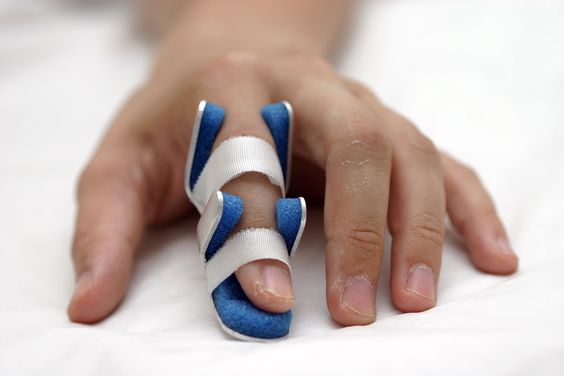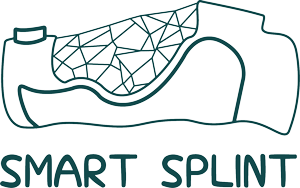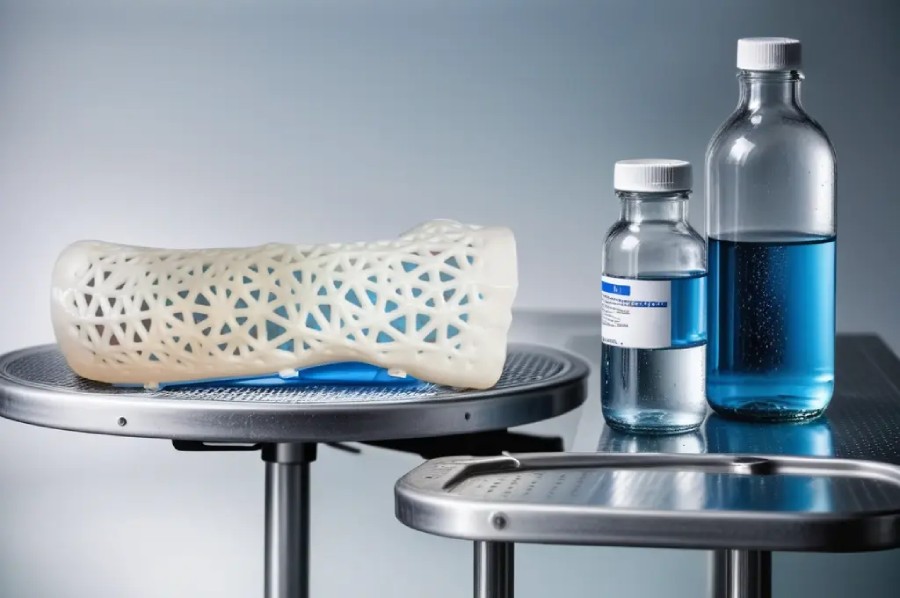While the principles of splinting remain the same, some modifications are necessary when splinting certain populations such as infants, children, elderly patients, and bariatric individuals. Here are some tips for splinting in these special circumstances.
Splinting injuries in small children requires extra care and gentleness. Splint materials must be well-padded and molded securely but not too tightly to avoid constricting circulation. Close monitoring of neurovascular status is vital. Consider splinting multiple small digits together rather than individually to reduce anxiety. Involve parents in calming/distraction techniques. Consider pain medication as needed.
Proper positioning is important as the growth plates in children are still developing. Splint major long bone fractures in slight overcorrection to allow for swelling without displacing the fracture. For wrist/forearm injuries, slightly flex the elbow. Younger children may require ankle/knee immobilizers rather than long leg casts depending on the injury. Secure splints with multiple strips of tape rather than elastic as it is less constricting. Skin integrity is also a major concern for the elderly. Use additional padding on bony prominences and check skin regularly to prevent pressure injuries. Gentle securement and looser wrapping prevent pressure and shearing forces. Monitor confusion/agitation closely. Here are some tips for splinting in these special circumstances.

Infants & Young Children
Splinting injuries in small children requires extra care and gentleness. Splint materials must be well-padded and molded securely but not too tightly to avoid constricting circulation. Close monitoring of neurovascular status is vital, especially in infants who cannot communicate pain or discomfort. Consider splinting multiple small digits together rather than individually to reduce anxiety and distress for the child. Involve parents in calming distraction techniques, such as storytelling or singing, during splint application. Pain medication should be strongly considered for even minor injuries, as untreated pain can have long-term developmental effects in young patients.
Proper positioning is especially important as the growth plates in children are still fusing. Splint major long bone fractures in slight overcorrection to allow for swelling without displacing or further injuring the fracture. For wrist or forearm injuries, slightly flexing the elbow keeps the child comfortable. Younger children may only require ankle or knee immobilizers instead of long leg casts depending on the injury characteristics and size. Secure splints gently with multiple strips of microporous tape instead of tightly wrapped elastic bands, as these can easily constrict circulation in tiny limbs.
Be aware that injuries may actually be more extensive than they initially appear in children due to growth plate involvement. Consider consulting pediatric orthopedics or trauma specialists early for guidance. Reassure anxious parents that splinting will protect the injured area during healing. Monitor children closely for changes that may indicate a circulatory compromise under the splint.
Elderly Patients
When splinting elderly patients, skin integrity is paramount. The skin thins with age and is more prone to pressure injuries, especially over bony areas. Use copious padding on all prominent bones before applying any splint material. Check the skin under the splint regularly for any signs of redness or breakdown. Gently secure the splint with multiple layers of soft wraps rather than tight, constricting bandages. Consider splint options like air splints that do not require much wrapping at all. Keeping the skin well-padded and splint securement lose prevents dangerous pressure and shearing forces on fragile elderly skin.
The elderly is also more susceptible to hypothermia, so take care to keep them warm throughout the splinting process. Injuries should be immobilized in positions that minimize the risk of stiffness and contractures, as these complications are more likely in older patients with less mobile joints. Monitor them closely for signs of confusion, agitation, or delirium that can sometimes arise from injuries, procedures, or pain in elderly individuals. Splint in a calm, low-stimulation environment whenever possible. Consult family members about baseline mental function or behaviors.
Be vigilant for any skin changes under the splint from fluid shifts or new complaints of discomfort. The elderly heals more slowly, so injuries may seem minor but require careful follow-up. overall, splint the elderly with extreme gentleness, padding, and attention to skin integrity.
Bariatric Patients
Splinting injuries in obese individuals require additional support for their excess weight. Using splint materials that are much wider and longer than usual can accommodate larger limbs and bodies. Extra padding is crucial, not just under the potential splint site but also wherever the weight of a large abdomen or breasts may create pressure points. Consider involving additional rescuers when setting fractures or immobilizing injuries in very heavy patients. Thoroughly assess what medical equipment, such as bariatric stretchers or specialty slings, may be needed to safely transfer obese individuals for further care.
Tape alone often cannot adequately secure very large or heavy splints. Reinforce tape borders with multiple overlapped loops of elastic bandages or consider using commercially available splint binders that fasten together. Pay close attention to skin integrity under pannus folds, in the groin or axillary regions, as circulation can be easily compromised in these areas. Gentle intermittent central padding may be needed. Monitor bariatric patients, some of whom are also diabetics or have limited mobility, exceptionally closely for swelling changes under and around splints over longer periods. Keep them stabilized in safe, comfortable positions that don’t compromise airways during this extended monitoring. Consult bariatric emergency response teams early for complex injuries if available. Overall, rescuing and splinting obese patients requires modified techniques, extra resources, and careful monitoring.
General modifications:
When splinting injured limbs or joints, it is important to make modifications and adjustments to minimize discomfort and prevent further harm. Some general modifications to consider include:
Use wider or longer splint materials to fully cover and immobilize injured areas. Having splints that are too narrow or short can lead to inadequate support and continued motion that aggravates injuries. Extending splint length and width provides more comprehensive stabilization of fractures or sprains.
Reinforce tape borders and stress points with multiple overlapping strips to increase adhesion and distribute pressure. The ends and sides of tapes are vulnerable to peeling or detachment and warrant extra tape layers. Areas over joints or mobile regions also benefit from tape doubling to maintain integrity.
Place padding, gauze, or moleskin under any straps or elastic bands to buffer skin from direct pressure and friction. Unprotected skin under tight restraints is susceptible to irritation, blistering, or tissue damage. Soft barriers relieve pressure and rubbing.
Consider soft splint options like padded boards or flexible thermoplastic materials that mold to anatomy. These reduce the need for tight circumferential wrapping while still limiting motion. Tight wrappings can constrict blood flow if too compressive.
Monitor frequently for increased swelling, numbness, or color changes distal to the splint that may indicate dangerous constriction. Adjust tapes and straps promptly to restore circulation.
Carefully assess needed assistance for lifting or moving patients with splinted injuries to avoid causing further displacement or damage during extrication and transfers. Added support and immobilization is key.
Other Populations
Certain patient populations require additional precautions and modifications when applying splints for injuries.
For burn patients, liberal padding beneath all splinting materials is critical to avoid direct contact with damaged skin or blisters, which could lead to infection or further injury. Soft gauze dressings on burns should be inspected frequently under splints to monitor for increased seepage or swelling that requires attention. Major long bone fractures in those with full-thickness burns may need placement in traction splints for stability en route to prevent excessive motion. Air ambulance transport directly to a burn center should be strongly considered.
In remote or wilderness settings, high-energy traumatic fractures have higher risks without quick access to definitive surgical care. Splinting will provide temporary immobilization, but early specialist consultation is warranted given the higher probability of complications like internal bleeding or compartment syndrome. The use of emergency air transports may be indicated to expedite transfers to trauma centers able to fully stabilize significant multi-system injuries.
For elderly patients, extra care should be taken to monitor neurovascular status distal to fractures, as age-related conditions like osteoporosis or atherosclerosis increase risks if circulation is compromised by overly tight splinting. Those with diabetes or autoimmune disorders may also have impaired healing capacity.
In children, the short and rounded contours of smaller limbs can make proper splinting more difficult. Using well-padded, soft splints molded carefully to pediatric anatomy helps prevent looseness or pressure points. Parents should be fully educated on monitoring for problems if kids are splinted and discharged.
Those with multiple comorbidities like heart failure or morbid obesity present greater challenges to proper stabilization and make close reassessment essential given their complex medical status. Comprehensive documentation and communication with receiving facilities is key for these higher-risk patients.
In summary, splinting injuries in special populations involves modifications for pediatric, geriatric, obese, and other high-risk patients to ensure immobilization while protecting vulnerable anatomy from pressure, swelling, or other complicating factors. Gentle techniques, sufficient padding and securement, frequent monitoring, and positioning for comfort are key. Partnering with specialists expedites care when multiple injuries or medical complexities exist.



